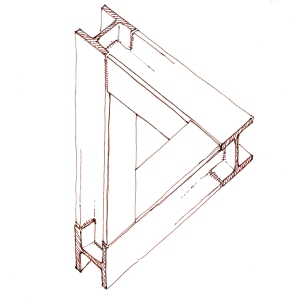Truss

Wood truss Queenpost and its different elements and joints.
También llamado cuchillo o armadura de cubierta, es una celosía de canto variable y pendiente a una o dos aguas. Al tener sus nudos generalmente articulados y barras de gran esbeltez, la estructura adquiere su rigidez gracias a que las barras se combinan formando triángulos. Sobre la cercha y sus sucesivas repeticiones paralelas se apoyan las correas.
Como cualquier celosía, las cerchas pueden construirse con diferentes materiales: acero, madera, aluminio… o una combinación de varios en la que se aproveche las propiedades de cada uno. Las uniones pueden ser articuladas o rígidas.
A diferencia de otros sistemas estructurales en los que la condición de rigidez se consigue por la construcción de los nudos, en este tipo de estructuras las barras trabajan predominantemente bajo esfuerzos axiles. Por el contrario, los esfuerzos flectores y cortantes son relativamente pequeños.
En la construcción tradicional de una cercha de madera es fácil observar la naturaleza de los esfuerzos axiles. El pendolón se sitúa entre los dos pares que lo comprimen. Del mismo modo, cada par apoya sobre su tornapunta, provocando que trabaje a compresión. Por el contrario, el pendolón y el tirante trabajan a tracción, lo que permite que, en numerosas ocasiones, en cerchas de madera, estas piezas sean de hierro o acero .
The trusses of the structure are called frames or ceiling frameworks; it is a lattice with different height with a one- or two-sided slope, as its knots are generally articulated joints and bars of great slenderness. The structure gets its rigidity by forming triangles using the wooden bars; the straps are supported by the truss and its successive parallel repetitions.
As any lattice structure that we can build, the trusses can be made with different materials such as steel, wood, aluminium, etc. or a combination of them, which will then benefit from the properties of each material that is used; the joints can be articulated or rigid.
Unlike others structural systems which get rigidity with the construction of the joints, in this type of structures the bars work under axial forces. On the other hand, the bending and shear stresses are relatively small.
In the traditional construction of a wooden truss, it is easy to see the types of axial forces that it is submitted to. The pendulum is situated between the two main rafters which compress it. Similarly, each of the main rafters leans on a strut which is subjected to compressive stress. On the other hand, the pendulum and brace work under tension, which allows these pieces to be made of iron or steel.


Pingback: Antepecho medianero en una nave – Dibujando Hierros
Pingback: Refuerzo de un forjado reticular mediante tirantes de acero – Dibujando Hierros